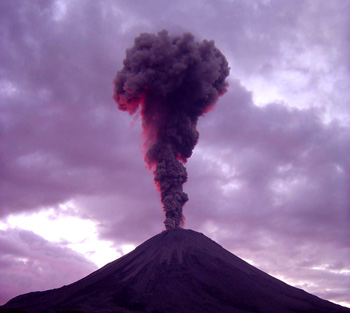Kamtschatka: Aktive Vulkane soweit das Auge reicht
May 08, 2004 Pedro May Asien, Russland (Asien), 0

Wissenschaftler aus der ganzen Welt erfahren hier wie unser Globus entstanden sein könnte. Eine Forschungsstation jagd die Nächste. Die Natur ist hier auf dem Stand der Entstehungsgeschichte unserer Erde. Über 300 Vulkane (davon sind aktuell ca. 29 aktiv), Erdbeben und Zyklone erzählen davon, wie es einst auch in unserer Heimat ausgesehen haben könnte.
Der Karimski Vulkan entspricht der klassischen Vorstellung eines Vulkanes. Ein perfekter Konus aus dessen Spitze Asche kilometerhoch in die Luft schießt. In wenigen Stunden ist die weiße Schneepracht viele Kilometer um den Vulkan in ein schwarzes Ascheemeer verwandelt. Wer dann den Karimski abboardet, zieht eine weiße Spur in den schwarzen Schnee. Eine absolute Sensation!
Der Karimski-Vulkan hat auch noch einen kleinen See auf seiner Seite. Nicht nur höchst fotogen, sondern auch immer mit feinem Wind bestückt. Also Sommer wie Winter ein perfektes Kite Eldorado am Fuße eines aktiven Vulkans. Somit ist der Karimski nicht nur besonders schön und aktiv, sondern auch etwas wirklich einmaliges auf der Welt! Nicht nur für Boardsportler!
Kamtchatka Vision (incomming-agency) beschreibt den Vulkan der Vulkane
Karymsky volcano is a relatively short (1,486 m) and young (6,100years old) volcano, the most active one in Kamchatka.
The eruptions of Karymsky volcano are accompanied with bursts and throw-outs of ash and bombs going out from the central crater, with lava effusing. As a rule, the lava of Karymsky are so glutinous that the flaming torrents do not always reach the foot of the volcano.
There has been also an under-water eruption in the Karymsky lake that is 6 km away from the volcano. It lasted not more than 18-20 hours, but that short period included over 100 under-water bursts each accompanied with waves tsunami 15 meters high. The lake was actually boiling. The temperature went up rapidly, and salt and acid components reached the concentration that killed all the life in the lake including the school of “kokani”, a lake species of sock-eye salmon cultivated by ichthyologists in the Karymsky lake.
As a result of this eruption, the Karymsky lake that used to be ultra-fresh turned into the biggest natural reservoir of acid water in the world.
Passende Artikel
-
 Öffentlichkeitsarbeit:...
Öffentlichkeitsarbeit:...Jun 29, 2023 0
-
 Schülerpraktikum in Mexiko in Medizin,...
Schülerpraktikum in Mexiko in Medizin,...Jun 28, 2023 0
-
 Guacamole mit Grashüpfern schlemmen...
Guacamole mit Grashüpfern schlemmen...Nov 06, 2022 0
-
 Öffentlichkeitsarbeit: Minderheiten in...
Öffentlichkeitsarbeit: Minderheiten in...May 29, 2020 0





















